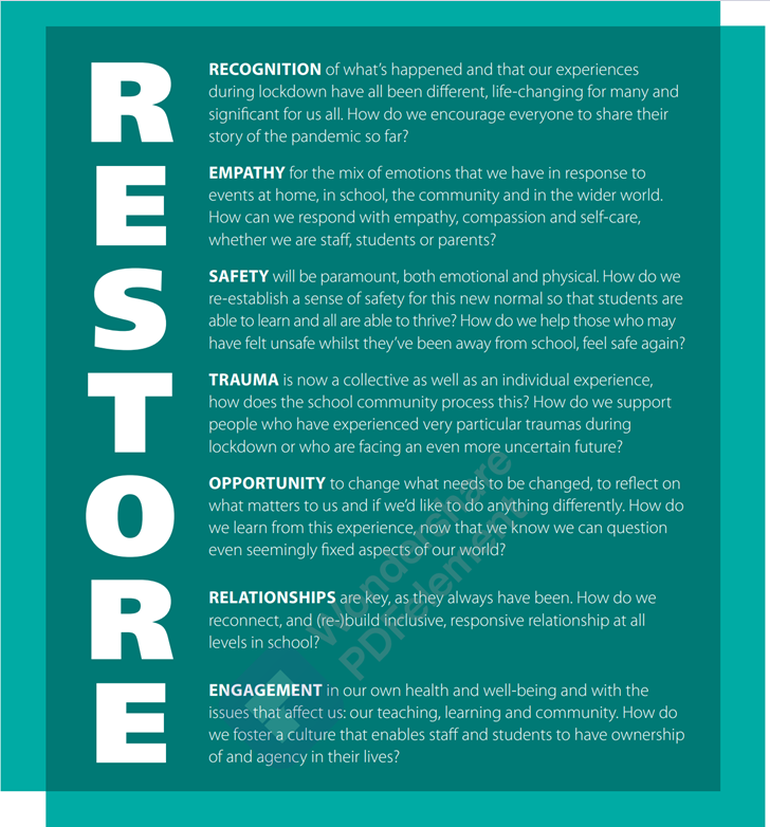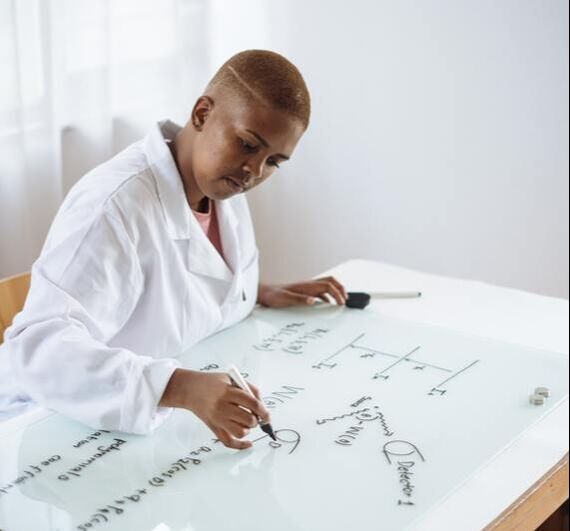|
Schools & Solutions proposes to develop an innovative and interactive way to include the school community (students, teachers, principals, parents, community NGO, etc.) in creating solutions for problems.
More precisely, the project aims to use upscaling existing restorative approaches and train teachers to deal with complex school realities, using restorative practices, creating mechanisms for improving student behavior and reducing the need for suspensions. |
News
|
The two students of CEIP Alba Plata go to class wearing masks after the conflict was resolved thanks to mediation. Cáceres, September 21, 2021 They have gone to school today with their masks, so that "the conflict has been resolved in the educational environment thanks to mediation, the monitoring carried out from the school and the willingness of the family to constant dialogue". [Read more] |
While the pandemic brought an unprecedented halt to school activity for millions of children, the return to school attendance and the lifting of restrictions means that many pupils are once again facing one of their worst nightmares: bullying. Cyberbullying, the most frequent form of bullying [Read more] |
The Schools & Solutions project focuses on the Restorative approach in education to resolve conflicts, bullying, classroom disruption, poor attendance, antisocial behavior, and disputes between students, their families, and members of staff.
The goals of the project are:
The restorative approach in schools is values-based and needs-led. It highlights the importance of relationships for emotional wellbeing, resolving conflict, preventing harm and building resilient communities. The approach works by ensuring a consistent and congruent approach to the building, maintaining and repairing of relationships.
For more info: https://restoreourschools
The Tool kit is available here: :https://restoreourschools.files.wordpress. com/2020/05/restore.pdf (Free Resources)
#schools #solutions#schoolsandsolutions #europeanproject
The goals of the project are:
- To develop innovate and interactive ways to include the school community (students, teachers, principals, parents, community NGO, etc.) in creating solutions for problems
- To train teachers to deal with complex school realities, using restorative practices
- To create mechanisms for improving student behavior and reducing the need for suspensions helping to respond to conflict in ways that repair damaged relationships
- To convert damage on opportunities for students to take responsibility and accountability for
The restorative approach in schools is values-based and needs-led. It highlights the importance of relationships for emotional wellbeing, resolving conflict, preventing harm and building resilient communities. The approach works by ensuring a consistent and congruent approach to the building, maintaining and repairing of relationships.
For more info: https://restoreourschools
The Tool kit is available here: :https://restoreourschools.files.wordpress. com/2020/05/restore.pdf (Free Resources)
#schools #solutions#schoolsandsolutions #europeanproject
Our partners from Turkey created a short and interesting video that presents the whole project, with its objectives
and what partners have proposed to achieve
Check this out!
and what partners have proposed to achieve
Check this out!
Three restorative practices to implement in 2021
Strong relationships and a sense of safety are at the heart of a positive school climate. Especially as we grapple with the global COVID-19 crisis and the reckoning over racial injustice, it has become increasingly important to cultivate supportive school communities.
Restorative practices provide students and caring adults with an intentional, inclusive, and respectful way of thinking about, talking about, and responding to issues or problems that arise. When integrated in a school community, restorative practices help to build and repair relationships, prioritize student agency, and de-emphasize punitive discipline in favor of communication to resolve conflict.
Popular examples of restorative processes include affective statements, community-building circles, small impromptu conferencing, and setting classroom agreements or norms.
Restorative approaches are designed to empower students to learn from their mistakes, to understand the impact of their actions, and to grow personally in their ability to problem-solve and make responsible decisions.
The goal of any restorative practice is to build a sense of community in the classroom by:
· Providing pathways to repair harm
· Bringing together individuals impacted by an issue in a dialogue
· Achieving a common understanding
· Coming to an agreement about resolving the conflict and moving forward
Many thins are achievable by involving restorative practises like respect agreement, restorative inquiry and re-entry circles in the daily school life.
To learn how to do it and to read more about restorative practises go to this blog.
Strong relationships and a sense of safety are at the heart of a positive school climate. Especially as we grapple with the global COVID-19 crisis and the reckoning over racial injustice, it has become increasingly important to cultivate supportive school communities.
Restorative practices provide students and caring adults with an intentional, inclusive, and respectful way of thinking about, talking about, and responding to issues or problems that arise. When integrated in a school community, restorative practices help to build and repair relationships, prioritize student agency, and de-emphasize punitive discipline in favor of communication to resolve conflict.
Popular examples of restorative processes include affective statements, community-building circles, small impromptu conferencing, and setting classroom agreements or norms.
Restorative approaches are designed to empower students to learn from their mistakes, to understand the impact of their actions, and to grow personally in their ability to problem-solve and make responsible decisions.
The goal of any restorative practice is to build a sense of community in the classroom by:
· Providing pathways to repair harm
· Bringing together individuals impacted by an issue in a dialogue
· Achieving a common understanding
· Coming to an agreement about resolving the conflict and moving forward
Many thins are achievable by involving restorative practises like respect agreement, restorative inquiry and re-entry circles in the daily school life.
To learn how to do it and to read more about restorative practises go to this blog.
Ways to implement restorative practices in the classroom
There is more and more interest in moving away from “traditional” school discipline and toward restorative practices. Countless studies have shown that traditional discipline practices are no longer effective in today’s schools. In fact, traditional practices were so commonplace in part because the ability to apply an immediate consequence was less time consuming for the one doling out the punishment. However, we now embrace restorative practices because they draw their strength in their ability to empower students to learn from unacceptable choices, to understand their impact, and to grow personally in their ability to make more sound decisions and resolve problems. Restorative practices represent a positive step forward in helping all students learn to resolve disagreements, take ownership of their behavior, and engage in acts of empathy and forgiveness.
There are many ways to implement restorative practices in the classroom. First, teachers can incorporate daily morning meetings to build relationships with students, get a sense of their social/emotional mindset, and set the tone and focus for the instructional day. Teachers can also utilize goal setting with their students as a restorative practice. With goal setting, students take ownership of areas they’d like to improve (academically or socially), and they set realistic and actionable steps to work toward their goal. By providing individual goal conferences, teachers can check in to see if students are on track to meet their goals, and students learn to self-check and refocus as needed.
Another useful strategy is when an unacceptable behavior has happened that the teacher allows the offended student to share how the offense made him/her feel. In this way, the offender is able to understand how his/her behavior impacts others and therefore understand the perspective of the other person. Finally, there is great restorative power in having the student who has made an unacceptable choice reflect on his/her behavior in writing by addressing very specific questions like: What choice did I make? How did my choice impact others? Is there a better way that I could have addressed this situation? If I had the opportunity for a redo, would I make the same choice? Why or why not?
There are a number of benefits or restorative practices! Visit website and learn about them!
There is more and more interest in moving away from “traditional” school discipline and toward restorative practices. Countless studies have shown that traditional discipline practices are no longer effective in today’s schools. In fact, traditional practices were so commonplace in part because the ability to apply an immediate consequence was less time consuming for the one doling out the punishment. However, we now embrace restorative practices because they draw their strength in their ability to empower students to learn from unacceptable choices, to understand their impact, and to grow personally in their ability to make more sound decisions and resolve problems. Restorative practices represent a positive step forward in helping all students learn to resolve disagreements, take ownership of their behavior, and engage in acts of empathy and forgiveness.
There are many ways to implement restorative practices in the classroom. First, teachers can incorporate daily morning meetings to build relationships with students, get a sense of their social/emotional mindset, and set the tone and focus for the instructional day. Teachers can also utilize goal setting with their students as a restorative practice. With goal setting, students take ownership of areas they’d like to improve (academically or socially), and they set realistic and actionable steps to work toward their goal. By providing individual goal conferences, teachers can check in to see if students are on track to meet their goals, and students learn to self-check and refocus as needed.
Another useful strategy is when an unacceptable behavior has happened that the teacher allows the offended student to share how the offense made him/her feel. In this way, the offender is able to understand how his/her behavior impacts others and therefore understand the perspective of the other person. Finally, there is great restorative power in having the student who has made an unacceptable choice reflect on his/her behavior in writing by addressing very specific questions like: What choice did I make? How did my choice impact others? Is there a better way that I could have addressed this situation? If I had the opportunity for a redo, would I make the same choice? Why or why not?
There are a number of benefits or restorative practices! Visit website and learn about them!






